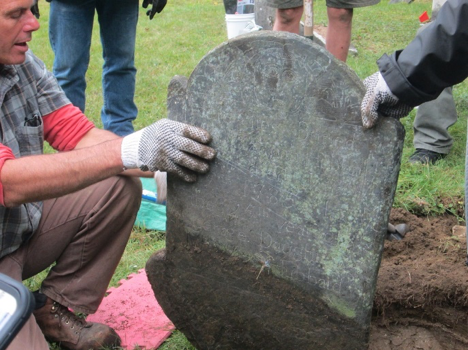
Judy Hayward
Finding Life in the Cities of the Dead
A few weeks ago, I had the pleasure of organizing a workshop about conservation of cemetery stones and landscapes. The setting was the Old South Church cemetery in Windsor, Vermont. I wrote about Asher Benjamin and the church in this column in June 2018, but this workshop opened my eyes to the stewardship of cemeteries; there are many parallels to architectural conservation.
Making connections to the past is a joyous part of my work but caring for the stones and their setting personalized the work and imbued me with a direct connection to the people whose stones we worked on during the training. Interpreting a sense of place is integral to historic buildings, but cemeteries have a sense of place too. Many of the stones draw inspiration from the architectural elements of a given period in American architecture. Some of the stones have the signature of their carvers and that is a powerful reminder that we find hand-craftsmanship in cemeteries.
We began with learning about conditions assessments for both the stone and landscape of the cemetery. We identified the character-defining features right off the bat. We asked ourselves what are the goals for a cemetery? How should it appear? Are perfectly manicured lawns and treeless experiences good, bad or indifferent? Brian Post, a landscape architect and executive director of The Stone Trust told us that some cemetery sextons are advising to mow less frequently or even use goats for lawn care- they eat everything including poison ivy and they fertilize the grass. Less mowing means less damage to headstones and less cost, so with budget savings, funds can be redirected to conservation efforts. Denuding a cemetery of its trees might solve some problems but if it robs the cemetery of its character, we don’t gain anything. If planting trees can help fight climate change, can cemeteries be areas where we replace trees that have outlived their safety?
When it comes to cleaning and repairs, National Park Service Historian Dennis Montagna and Francis Miller, http://conserve-art.com/, recommend gentle chemicals and soft mortars that allow retreatment in the future. We established a test zone with different solutions of cleaning materials that can be monitored locally so that decisions about the best cleaning method and preferred appearances can be made after watching the evolution of the stones over the next few years.
The experience has brought me in contact with people who have ancestors in the Old South Cemetery. Sharing their sense of pride at having ancestors, some of whom served in the Revolutionary War or were active in civic affairs, is delightful. In a few weeks, we have a volunteer conditions assessment planned; many of the workshop attendees are coming back to help us document conditions to plan for the long-term preservation of this historic cemetery.
So, this Halloween, instead of avoiding cemeteries or succumbing to the spookiness of the holiday, I will be taking some strolls in my favorite cemeteries to reflect on their inhabitants and to savor the trees, the plants and the sense of place, and I hope you do too.
Judy L. Hayward spends her days pursuing a passion for historic architecture and the ways in which it can be reused to sustain and grow healthy communities. She develops courses in partnership with builders, architects, traditional craftspeople and others to teach both historic preservation and traditional building skills. She has one foot in the nonprofit world as executive director of Historic Windsor and the Preservation Education Institute and the other foot in the world of media and information services as education director for the Traditional Building Conference Series and Online Education Program.






